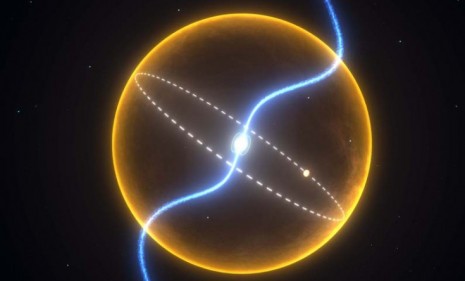A planet made of diamonds?
Astronomers have discovered a distant planet that they believe is made largely of crystalized carbon. Twinkle, twinkle...

Even Kim Kardashian can't match this: Australian astronomers say they've discovered an entire planet made of diamond — and it's roughly five times the size of the Earth. What's more, the sky-gazers report in the journal Science, the exotic planet orbits another rarity, a tiny pulsating ex-star that has been eating away at its companion for eons. Here, a brief guide to the massive diamond in the sky:
Is this for real?
The astronomers believe so. "The evolutionary history and amazing density of the planet all suggest it is comprised of carbon," with a little oxygen, says Matthew Bailes at Swinburne University of Technology in Melbourne. The intense gravitational pressure would crystalize the carbon, essentially creating one giant diamond.
The Week
Escape your echo chamber. Get the facts behind the news, plus analysis from multiple perspectives.

Sign up for The Week's Free Newsletters
From our morning news briefing to a weekly Good News Newsletter, get the best of The Week delivered directly to your inbox.
From our morning news briefing to a weekly Good News Newsletter, get the best of The Week delivered directly to your inbox.
How big is this giant gem?
The astronomers estimate that the diamond planet has about the same mass as Jupiter, but is 20 times denser and half as big — roughly 34,175 miles in diameter. The diamond planet is 4,000 light years away, in the Serpens constellation, about an eighth of the way toward the center of the Milky Way from our solar system.
Does it look like a diamond?
It's hard to know, says Travis Metcalfe at the National Center for Atmospheric Research in Boulder, Colorado. And though "it's highly speculative... if you shine a light on it, I can't see any reason why it wouldn't sparkle like a diamond."
A free daily email with the biggest news stories of the day – and the best features from TheWeek.com
Are there more diamond planets out there?
Possibly. But the stars had to align just right for this one to exist in the first place. Bailes says the planet used to be a massive white dwarf star, but had almost all its mass consumed by its orbiting partner, a rare millisecond pulsar — a tiny, fast-spinning neutron star that emits strong pulses of radiation. Still, Bailes is optimistic. "We've only processed a small fraction of space so far," he says, and with new supercomputers, "we should be in a strong position to possibly make many more discoveries like this one."
Sources: National Geographic, New Scientist, Reuters, Scientific American, Space.com
-
 Why is Trump’s alleged strike on Venezuela shrouded in so much secrecy?
Why is Trump’s alleged strike on Venezuela shrouded in so much secrecy?TODAY'S BIG QUESTION Trump’s comments have raised more questions than answers about what his administration is doing in the Southern Hemisphere
-
 Vance’s ‘next move will reveal whether the conservative movement can move past Trump’
Vance’s ‘next move will reveal whether the conservative movement can move past Trump’Instant Opinion Opinion, comment and editorials of the day
-
 Why recognizing Somaliland is so risky for Israel
Why recognizing Somaliland is so risky for IsraelTHE EXPLAINER By wading into one of North Africa’s most fraught political schisms, the Netanyahu government risks further international isolation